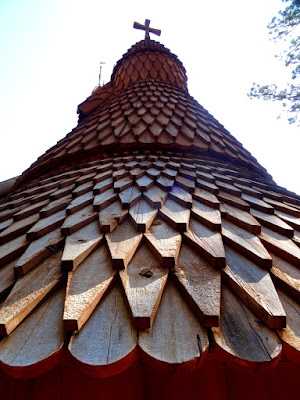Joani's research recommended a visit to the Chapel in the Hills. I would not have found it without Google Maps - it was just at the end of the street in an otherwise unremarkable little neighborhood. Once we parked we found the chapel was nestled on a beautiful hillside on well kept private grounds.
Being half Norwegian myself, I am always interested to see things pertaining to my roots, but this was well worth the visit even if you have no Norwegian blood!
This "Stabbur," (authentic grass-roofed storehouse) was built in Norway, disassembled and then reassembled on site. It serves as a gift shop and office.
This log cabin was built by a Norwegian prospector who came to the Black Hills during the gold rush.
It now serves as a museum and houses articles brought over from Norway or made by Scandinavians in this country during the 1800's.
This chapel, built in 1969, is an exact replica of the famous Borgund stavkirke, of Laerdal, Norway.
This is the Borgund stavkirke in Laerdal, Norway. It was built around the year 1150 and is considered the most completely preserved stave church still standing in Norway. (photo captured from the web)


The Norwegian Department of Antiquities graciously provided a set of blueprints of the Borgund church to be used in the construction of the Chapel in the Hills.
The land, the chapel and structures, and landscaping were made possible through a generous gift by Mr. and Mrs. Arndt E. Dahl, of Rapid City.
The only metal used was on the ornate door furnishings and locks. Instead of nails, they used wooden dowel pins to build the church.
Stavkirkes were built by the same people that built Viking longboats, many of the construction techniques are similar.
The Vikings brought their woodcarving skills along with their construction techniques to the building of the Stavkirkes.
As an interesting little aside, we learned the church was welcoming to everyone, even those affected by leprosy. The sick would take communion at the small slide window to the right of the altar.
This chapel is an exact replica of the Borgund stavkirke of Laerdal, Norway with two exceptions. The Norwegian Department of Antiquities graciously allowed the addition of wooden floors instead of dirt and the addition of simple bench pews.
One of the more quirky sites around Rapid City is Dinosaur Park. It is located on a hill overlooking the downtown area. The dinosaurs were constructed by the WPA in 1936 (a work program of the 30's) in recognition of the importance of South Dakota in the science of paleontology.
Dinosaur Park is worth a visit even if you don't have little ones in tow. It is such a short drive and the views are spectacular.
David is always willing to snap pictures for appreciative families. He also obliged the folks in the foreground.
Practically across the street from our campground was the Dakotah Steakhouse. This high-end restaurant had a John Lopez sculpture on display amid their entryway landscaping, so we made a quick stop for some pictures. "Who is John Lopez?" you may ask. Upon doing research for South Dakota, Joani had become enthralled by the work of this artist whose studio is located in Lemmon, SD. You guessed it, we will be overnighting in Lemmon, SD, on our way to Bismarck, ND. I think it is her goal to see every piece that Mr. Lopez has created. Unfortunately, a few are located in New Hampshire so those may be a challenge to see.
When you study this closely you see so many individual pieces of metal that you would just never imagine as part of a sculpture. Somehow they all blend into this beautiful, perfectly proportioned piece of art.
This piece definitely whets our appetite for more, so we are looking forward to our Lemmon, SD, visit.

























No comments:
Post a Comment